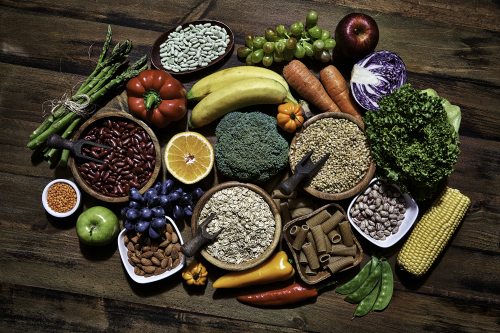Fiber in the Kidney Diet

Fiber is an important nutrient in the kidney diet. This essential part of carbohydrates helps your body function smoothly. In healthy diets, fiber can be found in plant foods such as vegetables, fruits, grains, nuts and beans.
Most people do not get enough fiber in their diets. Most adults need 25 to 30 grams of fiber daily, but the average American only gets about 15 grams!
Types of Fiber
Fiber comes in two different forms:
- Soluble fiber absorbs water and turns to a gel during digestion. This slows down digestion and can help you feel full after a meal. Find it in beans, oats and apples.
- Insoluble fiber is found in wheat bran, cauliflower and many vegetables. It adds bulk to the stool, which can help you stay regular.
5 High-Fiber Potential Benefits for People with Kidney Disease
Getting enough fiber in your diet can help with digestion and overall health. Some of the benefits of a high-fiber diet for people with kidney disease include the following. (2)
- Better Bowel Movements: Struggling with constipation? Fiber keeps things moving smoothly, reducing the risk of hemorrhoids and diverticular disease.
- Blood Sugar Support: Soluble fiber can help regulate bloods sugars if you have diabetes. Controlling blood sugar is important to reduce diabetes complications.
- Heart Health Boost: Lowering cholesterol and blood sugar levels through soluble fiber helps protect your cardiovascular system, reducing the risk of heart disease and stroke.
- Improved Gut Health: Fiber feeds the good bacteria in your gut, supporting a healthy microbiome, which is important for overall well-being.
- Reduced Cancer Risk: Studies suggest a link between high-fiber diets and a lower risk of colorectal cancer.
Fiber-Rich Foods for Your Kidney-Friendly Diet
Ready to add more fiber to your plate? Here are some delicious and kidney-friendly options:
- Fruits: Apples (with skin), apricots, berries, cherries, figs, peaches, pears (with skin), pineapple, plums
- Vegetables: Asparagus, beets, broccoli, Brussels sprouts, carrots, cauliflower, celery, collard greens, corn, green beans, green peas, lettuce, okra, onions, squash, zucchini
Tips for Increasing Your Fiber Intake Safely
Gradually increase your fiber intake to avoid gas, bloating or cramping. Here’s how:
- Variety is Key: Mix up your kidney-friendly fruits and vegetables.
- Embrace Whole Foods: Choose whole fruits over juice, and eat fruits and vegetables with their skins on (when appropriate).
- High-Fiber Cereals: Check with your dietitian for approved options.
- Fiber-Rich Snacks: Berries, vegetables and high-fiber crackers can be great choices.
It’s important to talk to your dietitian about slowly increasing your fiber intake and adjusting your fluid intake. For some people, increasing fiber is not enough to relive constipation. In those cases, increasing physical activity, or taking a laxative approved by your doctor, can help. 1.
REFERENCES:
- US Dietary Guidelines 2020-2025
- Mayo Clinic Dietary Fiber: Essential for a Healthy Diet
Additional Kidney Diet Resources
Visit DaVita.com and explore these diet and nutrition resources:
DaVita Kidney-Friendly Recipes
This article is for informational purposes only and is not a substitute for medical advice or treatment. Consult your physician and dietitian regarding your specific diagnosis, treatment, diet and health questions.

Recent Comments